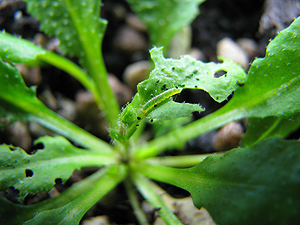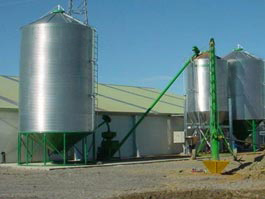Insect Control in Forage Brassicas

Mainly because of the wetter than normal Autumn 2012 there was lower than normal insect pressure on forage brassica crops, however as no two seasons are the same thought we would update you on the latest technology you can use to control brassica insects should they show up this season.
Once your brassica crop has passed the
establishment phase the major pests that will cause issues are
Diamondback Moth,
aphids and to a lesser extent
white butterfly.
Until now control of these pests has been difficult as the amount of water (mixed with an insecticide) required was large and therefore was often not correctly applied.
This lead to poor performance of the chemicals and exposed us to the real danger where pests build up an insecticide resistance, as has happened overseas.
Recently there have been some newer chemical technologies released that not only control these three, and most other pests but do so at lower and more achievable water rates.
Permethrin (25 g/L ) + pirimiphos - methyl (475 g/L) is available in
Attack (NuFarm) and in the soon to be released
Ambush (Orion) as well as one from Pasture First that will be released in the next couple of months.
For ground applications the suggesd use rate is between 750 mls to 1 litre per hectare (lower rate before canopy closure) in 100 to 300 litres of water mixed with a non-ionic wetting agent such as
Contact Low Foam.
I know many contractors say water is only a carrier but please the higher you go the better the job in this case.
For more information on the life cycle, damage caused and geographical spread of these common brassica pests follow the links below or
contact us if you have any questions.
Pasture Pest Download: Download the
Diamondback Moth life cycle information sheet.
Pasture Pest Download: Download the
Brassica Aphid information sheet.
Pasture Pest Download: Download the
White Butterfly information sheet.
Download: Click here to go to the
Specialty Seeds Downloads page for more downloadable information guides.
Contact Link: Please
contact Specialty Seeds for any pasture pest advice.
Back to top
 Calendar Girls and Boys
Calendar Girls and Boys

We recently heard through the grapevine that the Lincoln Young Farmers Club were doing a fundraising calendar. Specialty Seeds are always keen to support any fundraising so we jumped on board along with 11 other like minded companies.
The end result is a very tasteful 2013 calendar. Should you wish to support the Lincoln Young Farmers you can purchase them by following these simple instructions:
For online sales: please deposit NZD$15.00 into bank account number 06 0801 0574987 01 with your name as the reference. Then email your reference name and address to
lyfcalendar2013@gmail.com
Pre-ordering online is a great way to secure a calendar before they all sell out!
Back to top
 Silo Hygiene
Silo Hygiene

This time of the year a lot of our arable and dairy clients start seeing the bottom of their grain silos so we thought it would be a great idea to give you simple tips on silo hygiene.
I have over the years been witness to several cases of insect infestation in grain storage areas and the damage and cost of repair far outweighs the effort in maintaining good silo hygiene practices.
Hygiene
The first grain harvested is often at the greatest risk of early insect infestation due to contamination:
- Remove grain residues from empty storages and grain handling equipment, including harvesters, field bins, augers and silos to ensure an uncontaminated start for new-season grain
- Clean equipment by blowing or hosing residues and dust out and then follow the treatment instructions below
- Clean up around storages, removing weeds and rubbish. Mow around the storage facility and ensure easy access to the storage facility
- Remove and discard any grain left in hoppers and bags from the grain storage site so it doesn't provide a habitat for pests during the off season.
Treatments
This should a three step approach as follows:
- When you have completely emptied and cleaned out your silo we recommend you spray them and all grain handling equipment out using Actellic 50 EC at 200 mls in 10 litres of water.
- Once you have cleaned and sprayed out your silos we suggest you fumigate them out with Actellic smoke generators (great fun).
These are used at one smoke generator per 500 cubic metres, as a rule of thumb this means you would use 1 smoke generator for silos (including cone base and roof) between 24 to 240 tonnes.
If you would like the formula needed to work out the cubic metres of your silo please contact us.
- Grain going into the cleaned and fumigated silo should be treated with Actellic Dust at a rate of 200 grams of dust per 1 tonne of grain.
Things to monitor when silos are filled Insect pests Grain temperature Grain moisture content.
Warning: Ventilate silos before entering and never enter a silo while it is being emptied. Use fumigants and chemicals carefully and follow the safety instructions on the label.
Download: Click here to download the
Silo Hygiene information guide.
Download: Click here to go to the
Specialty Seeds Downloads page for more downloadable information guides.
Contact Link: Please
contact Specialty Seeds if you have any questions here.
Back to top

Back to top
 Millet Seed in stock
Millet Seed in stock
For the last few years we have had a lot of enquiry for
Shirohie Japanese millet seed and not been able to supply. We now however have now got a good supply and will be happy to quote you now.
Specialty Seeds also have a wide range of
Sorghum also available, so please have a look on our
sorghum website page for more information.
For information on growing Millet and Sorghum (the same principals apply to both) please download the
Sorghum brochure.
Download: Click here to download the
Sorghum brochure
Downloads: Click here to go to the
Specialty Seeds Download's page for downloadable information guides.
Contact Link: Contact Specialty Seeds for any millet or sorghum advice.
Back to top


As always, we hope this issue has been of some value to you. If you have a comment on this newsletter or anything on our website, please give us a call on our
Freephone: 0800 727 8873, send us an email at:
mail@specseed.co.nz.
Kind Regards

Stephen Finch & David Percival
Specialty Seeds - New Zealand
